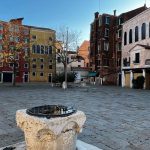THE JEWS IN VENICE (1516 – 1797)
GLI EBREI A VENEZIA (1516-1797).
BEFORE THE GHETTO
The Senate of the Most Serene Republic of Venice issued a decree on 29 March 1516 confining the Jews present in the city to a separate enclosure, segregating them from the rest of the population and marking the establishment of Italy’s first and oldest ghetto.
In the centuries before the ghetto was instituted, Jews lived for the most part in villages in the Venetian hinterland. Only a handful of families lived in Venice itself. Contemporary scholars tend to dismiss reports that Jews lived on the island of Giudecca, the name being more likely to come from the Venetian zudegà (families judged, found guilty and confined to the island). Jewish moneylenders and merchants from the hinterland were barred from all guilds and from owning property, thus if they were to survive they had no choice but to practice lending against security or trading in small second-hand items (strazarìa). They were allowed to reside in the city for no more than fifteen days in a row, during which time they could ply their trade in the Rialoto market, before returning to Mestre. Some were allowed to practice medicine. But no stable residency was permitted in the city until the early 16th century aside from a short period from 1382 to 1397 when, in an emergency, a temporary pass
THE ESTABLISHMENT OF THE GHETTO
After Venice was defeated at Agnadello in 1509 and a difficult social and economic situation set in, the Venetian government allowed Jews to reside in the city centre with a pass agreed on in 1513, in return for an annual tribute of 6,500 ducats. Many buildings close to Rialto housed Jewish families, but this sparked noisy protests from the preaching friars. So in 1515 a motion was submitted to the Senate urging that Jews be allowed to reside in the city in view of their contribution to the economy, but that they be confined to separate neighbourhoods. Rejecting a proposal to shut them up on the Giudecca or on the island of Murano, the Senate issued a decree on 29 March 5016 confining Jews to the “Ghetto Nuovo”.
“All Jews currently living in various parts of the city and those that come to the city hereafter are bound to go at once to live together in the houses situated in the Ghetto, a very spacious area close to [the church of] San Girolamo”.
It is estimated that roughly seven hundred German and Italian Jews, plus a handful of Levantine families, took up residence in the houses in the Ghetto Nuovo in a relatively short time, paying rent one-third higher than the standard rent and under the watchful eye of the stern Magistrates of the Most Serene Republic. Obliged throughout Italy to wear a distinctive badge with a yellow “O” on their clothing, the Jews of Venice, on the other hand, were forced to wear a yellow cap. Only a handful of bankers and medics were exempt from this order. The Ghetto was surrounded by high walls with gates that shut in the evening and only opened again at dawn, while guards salaried by the Jews themselves watched over the enclosure day and night, even sailing around the neighbouring canals.
THE TERM ‘GHETTO’
The jury is still out over the origin of the word “ghetto”. It is spelled in various different ways in old documents – ghèto, getto, ghetto, geto – but often indicates the place in which the Jews were enclosed, first in the Ghetto Nuovo and then in the Ghetto Vecchio. The “tract of land called the getto or the ghetto was the seat of the public foundries where bombards were cast (gettate in Italian)” and so “the place was called el getto because it contained over 12 foundries and bronze was cast there”. The word Ghetto thus appears to come from the name of the island on which the old foundries were situated. That, at any rate, is the explanation most popular with scholars today, other etymologies appearing to be more difficult to accept, so Venice is responsible for giving the world the word commonly used around the globe to indicate segregation and social discrimination.
THE THREE ‘NATIONS’ (COMMUNITIES) OF THE VENETIAN GHETTO IN THE 16TH CENTURY
For almost three centuries, from 1516 to 1797, coexistence among the different ethnic entities that had come to the city (Germans, Italians, Levantines and Ponentines, or Jews from the west) led to tension caused by differences of custom, language and tradition, but also by the Venetian government’s different treatment of the various groups. The German nation, which also included the Italians and was confined to the Campo di Ghetto Nuovo, was joined initially by the Levantine nation, which occupied the houses in the neighbouring streets of the Ghetto Vecchio in 1541 and which comprised ‘travelling’ Levantines (passing through) and ‘resident’ Levantines (who lived there stably) with their families. Later, however, the Jews from the west or Ponentine nation, comprising mostly Sephardic Jews hounded out of the Iberian peninsula in 1492, also appeared on the scene, taking up residence in the same streets, particularly after the pass issued in 1589. Other Sephardic Jews later explicitly requested, and were granted, a group of houses close to the Ghetto Nuovo, forming the Ghetto Nuovissimo in 1633. Thus the history of the “university of the Jews” (as the community as a whole was known) in Venice was for a long time a history of minorities in a society which, while composite in its makeup, was always united by a deep religious bond.
The German Jews (Ashkenazis) found refuge in the Veneto from the fearsome persecutions that sparked massacres in many central and eastern European cities as far back as during the Crusades. When the moneylenders and merchants were confined to the Ghetto Nuovo, they were forced to apply controlled interest rates (there were three rates in the 16th and 17th centuries: the green rate, the black rate and the red rate) and to engage only in the second-hand business (strazarìa) chiefly under the strict control of the Magistrates of Cattavèr. Yet despite these difficult circumstances, as early as between 1528 and 1532 they managed to build their splendid synagogues (the German Grand Shul and the Cantòn Shul) in which they could conduct their rituals. These synagogues were later joined by three Shuls in the Campo (Kohanim, Mesullamim and Luzzatto). For over a century after their confinement they kept the Yiddish language alive, also printing their prayer book (machzor) and operating Daniel Bomberg’s Jewish printing works, the most important such works in Venice.
The Italians, being part of the German nation, never formed a nation of their own. Having emigrated from Rome or from central Italy, they lived in the Ghetto Nuovo in the same difficult circumstances as the Germans, but they too managed to keep their cult alive, to develop a solid internal community organisation and, above all, to build their own synagogue (the Italian Shul) alongside the German places of worship in 1575.
The circumstances of the Levantine and Ponentine nations were a different matter altogether. They moved into the streets around the Ghetto Nuovo in the second half of the 16th century (in 1541 and 1589). Having become subjects of the Ottoman Empire, the Levantine Jews acquired a position of prestige in major maritime trade, thus Venice welcomed their presence in consideration of their contribution to the city’s economy. The Most Serene Republic placed them under the control of the Magistrature of the Cinque Savi alla Mercanzia and granted them the open space in the Ghetto Vecchio, where they were able to run their own hospital, an inn and a shelter for travelling merchants, and where they could display their wealth not only through their sumptuous dress but also, indeed above all, in the exuberant decoration of their great synagogue, the Levantine Shul.
In the neigbouring streets, the Ponentine Jews, who sought refuge here after they were hounded out of the Iberian peninsula in 1492 and were thus heirs to the great Spanish Jewish culture of the Middle Ages, considered Venice to be “the perfect state where a harmony of powers reigne”, as one of their most famous thinkers, Don Isacco Abrabanel, put it. Their representative Daniel Rodriga helped greatly in facilitating their settlement in the city thanks to the benefits incurred through the implementation of his proposals for the local economy, to the point where they were allowed to erect the largest synagogue in the entire Ghetto, the Spanish shul in which, like the Levantines, they were able to follow the Sephardic ritual with their own prayer books and to keep their own Spanish language alive for a very long time.
LIFE IN THE GHETTO (17TH TO 20TH CENTURIES)
The various nations’ different circumstances triggered tension and internal attrition throughout the first century of the Ghetto’s existence, but many of those differences had largely become a thing of the past by the early 17th century. The Germans became successful to a minor degree on the external market, the travelling and resident Levantines thrashed out an internal agreement amongst themselves, and the Ponentines consolidated their prestige to become a majority on the internal council representing the community before the government. Many historians consider this to have been the moment of greatest stability in the Venetian Ghetto. At a time when the Venetian nobility was losing its supremacy in the Mediterranean and becoming an increasingly landbound aristocracy, the trading opportunities for the Levantines and Ponentines acquired ever greater importance in the Republic’s economy, while the involvement of the Ghetto Vecchio in the management of the Ghetto Nuovo’s “poor banks” struck a fairer balance among the various nations. This age of internal stability fostered the broad development of study and of cultural activities. Tough external impositions such as a ban on the study of the Talmud, or certain serious internal events such as terrible plague of 1630, did not hinder the production of works of immense value. The phenomenon of Jewish publications that had led in the previous century to the production of the most important Jewish cultural works, with the contribution of Jewish thinkers, in printing works run by the Bombergs, the Giustiniani, the Bragadin and the Di Gara families, continued in the new century with the Stamparia Bragadina e Vendramina and with minor publishers, with whom the most celebrated rabbis of the period published their work. This was the age of Leon Modena, the most famous Venetian rabbi of all, a skilled preacher and the author of numerous works (including the important Historia de riti Hebraici), who gathered around himself a prestigious cultural elite which included Simone Luzzatto known for his celebrated Discorso on the state of Venetian Jews, the poetess Sara Copio Sullam whose Manifesto on the immortality of the soul may be considered a fully-fledged apology in defence of Judaism, and Moshè Zacuto who sought the inspiration for his poems and plays in the Lurianic Kabbalah.
These years of stability were fated not to last, however, because after the moments of illusion and disappointment triggered in Venice too by the appearance of the false messiah Shabbatay Tzevi, the crisis of the Most Serene Republic also sparked a crisis in the Ghetto’s three nations at the turn of the 17th century. In the course of the 18th century taxation rose, the public debt grew and lending terms worsened, a fact for which the community as a whole was held responsible. In that sense, the pass of 1777 marked the moment of greatest tension. Its articles imposed serious restrictions on many of the activities in which Jews were allowed to engage, and the timid overtures made in the pass of 1788 in an effort to make amends did little to improve the situation. The fall of the Republic – and of the Ghetto – was just around the corner. Even though the impoverishment of the Jewish community as a whole did not prevent the economic and financial success of certain leading families, the situation of widespread poverty in the Ghetto is clearly documented in a census taken in September 1797, which registered a population of 1,626 inhabitants, a majority of whom were in humble circumstances, working as servants, rag and bone merchants and shopkeepers. Few families were well off, and there was only one rabbi.
In that year, French troops under the command of Napoleon Bonaparte toppled the Republic of Venice and brought freedom for the Jews, who became citizens in every respect. The gates of the Ghetto were torn down and the tree of freedom was raised in the Campo del Ghetto. The Ghetto as a place of segregation and discrimination ceased to exist, after three centuries of an immensely chequered history.
Since then, following the liberation brought about by the French troops, the history of Venice’s Jews has developed along lines similar to those of Italy’s other Jewish communities. The Venetian community took part in the struggle for national unity known as the Risorgimento, it paid its tribute in blood during World War I, it lived through the terrible years of Fascism and of the Sho’ah, during which 246 of its members died in the concentration camps, and it gradually recovered to rise anew from the ashes and to start a new life after World War II. Today the Ghetto, the only one to have kept its structure of narrow streets and tiny squares intact, with its five splendid synagogues and its museum, still narrates the memories of a community that has lived in the lagoon city for centuries, often making a lofty contribution to Venetian culture and as an integral part of the long history of the city of Venice.
Marcella Ansaldi
Director of Museo Ebraico di Venezia
TICKETS AND INFORMATION
TICKETS AND INFORMATION
Visit the Venetian Ghetto
history, Jewish culture and its synagogues
















